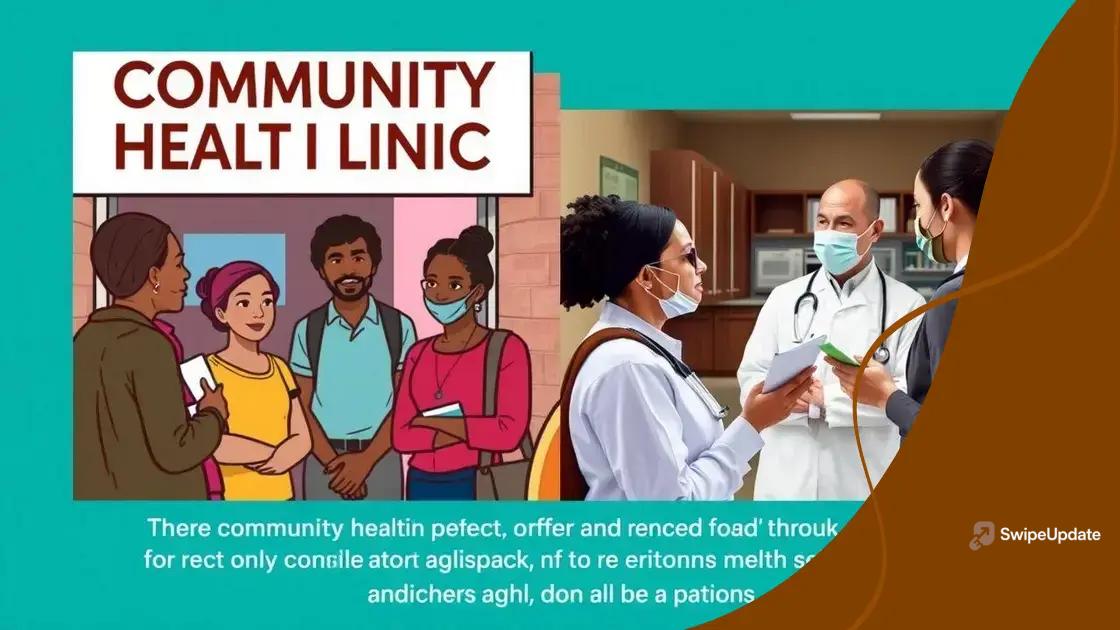Access to affordable prescription drugs: What you need to know

Access to affordable prescription drugs is crucial for improving health outcomes, driven by emerging policies, technological advancements, and increased consumer advocacy that work together to make medications more accessible and affordable.
Access to affordable prescription drugs is a crucial aspect of health care today. But did you know that many struggle to afford essential medications? Let’s dive into the factors influencing drug prices and potential solutions.
Understanding the cost of prescription drugs
Understanding the cost of prescription drugs can be complex, but it’s an important topic that affects many lives. Prices vary widely due to multiple factors, including the manufacturer, insurance coverage, and even location.
Factors Influencing Drug Prices
Several factors contribute to the high cost of medications. Here are some key elements:
- Research and Development: Creating new drugs involves extensive research, trials, and potential failures.
- Manufacturing Costs: The actual production and quality control of drugs can increase expenses.
- Market Competition: Limited competition can keep prices high, while generic options may drive down costs.
- Insurance Coverage: Your plan may affect how much you end up paying at the pharmacy.
Drug prices can change based on many variables that affect access and affordability. It’s crucial to be informed about these details, especially for those needing regular prescriptions.
How to Reduce Costs
There are strategies you can use to save on prescription medications. Consider the following:
- Shop Around: Prices can vary between pharmacies, so it pays to check.
- Generic Medications: Ask your doctor if a generic version of your medication is available.
- Discount Programs: Look for manufacturer discounts or assistance programs.
Being proactive about your medications can help you manage costs effectively. Finally, understanding the nuances of prescription drug pricing empowers you to make better decisions regarding your health.
The role of insurance in medication access
The role of insurance in medication access is significant, as it can determine how much you pay for prescriptions. Many people rely on their insurance plans to help cover these costs, but coverage varies widely.
Types of Insurance Plans
Understanding the different types of insurance can clarify how they impact medication access. Here are a few common options:
- Employer-Sponsored Plans: Many individuals receive health coverage through their jobs, which may provide better drug coverage.
- Government Programs: Medicare and Medicaid can help cover medication costs for seniors and low-income families.
- Individual Plans: Purchasing a private plan allows for more tailored coverage but may be more expensive.
Each type of insurance may have specific rules regarding what medications are covered and how much patients must pay. This can lead to confusion, especially when unexpected costs arise.
Understanding Your Benefits
Knowing your insurance benefits is key to accessing medications. It’s important to review your plan to understand:
- Co-pays and Deductibles: These are out-of-pocket costs you might pay before insurance kicks in.
- Formulary Lists: Check if your medication is on the approved list, as this can affect pricing.
- Prior Authorization: Some medications may require approval before the insurance will cover them.
Being informed about your insurance can save you money and ensure you get the medications you need. Remember, it’s worth reaching out to your insurance company if you have questions about your coverage.
Community programs providing affordable medications

Community programs providing affordable medications play a vital role in ensuring that everyone can access necessary prescriptions. These programs aim to bridge the gap for those who may not have insurance or cannot afford high medication costs.
Types of Community Programs
Various community initiatives offer support for individuals needing affordable medications. Some common types include:
- Prescription Assistance Programs: Many pharmaceutical companies offer programs that provide medications at reduced costs for eligible individuals.
- Community Health Clinics: These clinics often provide low- or no-cost medications to uninsured patients.
- Nonprofit Organizations: Groups like NeedyMeds and RxAssist help connect patients with resources to afford their prescriptions.
These programs can significantly ease the financial burden for many families. It’s essential to look for available resources within your community.
How to Access These Programs
Accessing community programs can be straightforward. Start by researching local clinics and organizations that provide medication assistance. You can often find information online or call directly for details.
- Check Eligibility: Many programs have specific eligibility requirements based on income or insurance status.
- Gather Documentation: Be prepared to provide financial information and proof of need.
- Apply Promptly: The application process can vary, so apply as soon as you identify a resource.
By becoming aware of these options, you can help ensure that you or your loved ones receive the medications necessary for good health. Community support is often available, and taking the initiative to seek help can lead to better health outcomes.
How to advocate for better drug prices
How to advocate for better drug prices is essential for anyone looking to manage healthcare costs. By understanding your rights and options, you can take meaningful steps to influence change.
Understanding Your Rights
First, familiarize yourself with your rights as a patient. Knowing what you can advocate for helps strengthen your position. It is your right to:
- Request price transparency: Ask your pharmacy and healthcare providers for clear pricing on medications.
- Challenge higher prices: If you believe a medication price is unfair, you can question it.
- Get involved: Participate in community meetings or forums discussing healthcare access.
Education is powerful, as is awareness of the healthcare landscape.
Effective Advocacy Strategies
When advocating for better drug prices, consider specific strategies that can make a difference:
- Contacting Your Representatives: Reach out to your local, state, and federal lawmakers to express your concerns about high drug prices.
- Joining Advocacy Groups: Organizations focused on healthcare reform can amplify your voice; joining them can provide resources and support.
- Sharing Your Story: Personal experiences resonate with others. Use social media or community events to share your story regarding drug costs.
Additionally, working closely with local organizations can foster greater awareness and pressure for change in drug pricing policies. The more individuals who speak out, the more likely it is to attract attention from decision-makers.
Staying Informed
Keeping yourself informed about health policies and potential changes in legislation will help you be an effective advocate. Subscribe to newsletters or follow reliable sources that cover drug pricing and healthcare developments. Staying updated allows you to respond to issues promptly and effectively.
Future trends in drug affordability
The future trends in drug affordability are important to watch as they can significantly impact patients and healthcare systems. As awareness around the high costs of medications grows, efforts to improve affordability are gaining momentum.
Emerging Policies
New policies aimed at increasing drug affordability are being discussed and implemented. Governments are considering:
- Price Negotiation: Allowing public agencies to negotiate drug prices directly with manufacturers could help reduce costs.
- Transparency Regulations: Laws requiring companies to disclose pricing practices may lead to greater accountability and more competitive pricing.
- International Options: Some propose allowing imports of medications from other countries where prices are lower.
These policies could create a more competitive environment and eventually lead to lower prices for consumers.
Technological Advancements
Technological advancements also play a significant role in making drugs more affordable. Innovations include:
- Telemedicine: Provides remote access to healthcare, potentially reducing costs associated with in-person visits.
- 3D Printing: This technology may allow for the on-demand production of drugs, which can decrease production costs.
- Online Pharmacies: These can streamline the purchasing process and offer lower prices by eliminating intermediaries.
By leveraging technology, the healthcare system can improve efficiency and reduce costs for patients.
Increased Consumer Advocacy
As consumers become more empowered, there will likely be a rise in advocacy for drug affordability. Patients are taking action by:
- Forming Support Groups: Communities that share resources and information about drug costs.
- Utilizing Social Media: Raising awareness of high prices and advocating for change through collective voices.
- Engaging with Policymakers: Actively communicating their needs and experiences to influence policy decisions.
This grassroots advocacy is crucial in driving the conversation about making medications affordable for everyone.
In conclusion, addressing drug affordability is crucial for improving health outcomes for individuals and communities. As we look to the future, emerging policies, technological advancements, and increased consumer advocacy all play vital roles in making medications more accessible. By staying informed and getting involved, we can advocate for change and encourage organizations and governments to work toward affordable prescription drug solutions. Together, we can create a better future for everyone.
FAQ – Frequently Asked Questions about Drug Affordability
What can individuals do to advocate for lower drug prices?
Individuals can contact their lawmakers, join advocacy groups, and share their personal stories to raise awareness about high drug prices.
How do new technologies impact drug affordability?
Technological advancements, such as telemedicine and 3D printing, can streamline processes and lower costs, making medications more affordable for consumers.
What role do community programs play in making medications affordable?
Community programs provide support and resources, including prescription assistance, to help individuals access necessary medications at lower costs.
Why is it important to stay informed about drug pricing policies?
Staying informed allows individuals to advocate effectively for changes and understand their rights regarding medication costs and access.
